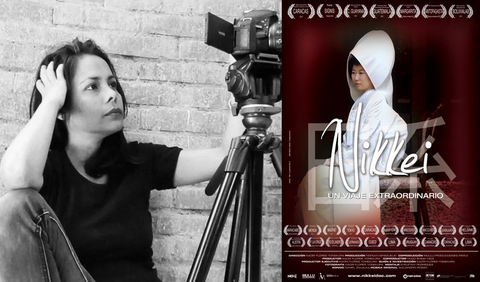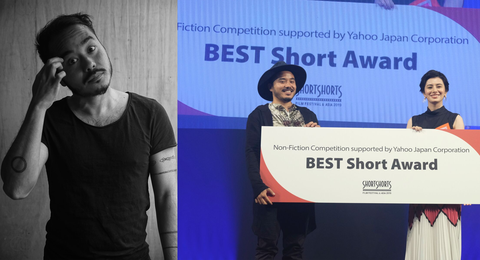Today's world is a movie. Everyone consumes, through cinema, digital platforms and other media, different videos and similar content that come from the most distant corners of the world through large and small screens. Many Nikkei are taking advantage of this resource to tell their stories, some linked to that origin from Japan, their Peruvian half or other identities. The stories of Kaori, Guillermo and Julio could be the first chapters of this account of creators.
Kaori Flores, Japan and Venezuela

Kaori Flores Yonekura is a Venezuelan filmmaker, graduated from the International School of Cinema and Television (EICTV) in San Antonio de los Baños, Cuba. He has participated in more than 20 works, individual and collective, the best known being his debut work, Nikkei (2011). This documentary, produced in Peru and Venezuela, addresses the history of Japanese immigration to Latin America. The film is about the construction of identity based on immigration.
“I used my grandparents' trip as a guide, explaining the economic, political, social and humanitarian conditions of different times.” Kaori says that she knew about the trip, but without many details. Like many Japanese, his grandparents were reserved. It was recorded in Peru, Venezuela and Japan, and was translated into English and Japanese.
From Japan they used the sounds of Tokyo machines and crows. From Peru, the pigeons and their traditional music. From Venezuela the sounds of the place. In 2023, the script of his fiction short film called “Oütsu” was selected in the Short Script competition of the Chihuahua International Film Festival. The story is about a healer who explores the connection between Earth and heaven. “My Nikkei identity is an essential part of me. In my creative process, this amalgamation of history, nature and culture becomes a perspective that influences how I tell my story and how I see the world,” he adds.
The connection with Japanese culture has provided him with narratives that help him reflect his identity, like “threads that weave the fabric of my way of seeing the world.” Through these stories he seeks to make the complexity and beauty of his connection with Nikkei and Japanese culture closer and more understandable to other people. In addition, Kaori Flores Yonekura has made other film works on Latin American culture, indigenism and human rights, and has also been a juror at various international festivals.
Currently, Kaori Flores Yonekura is in the post-production of her second feature-length documentary: The Extraordinary Journey of the Dragon , made with an archive of 900 photographs, and in the development of her first fiction feature Tetsuo's Crystal , based on a short story of the same name written for which it is available on platforms such as Kindle.
Guillermo Isa: ancestral communities

Guillermo Isa Palomino is 39 years old, born in Peru and is a fiction and documentary film director, as well as an art director. He has worked in plays, television shows and films. Among the latter, his stories about the native and ancestral traditions of the peoples of Peru and Colombia stand out. In 2019, he won the Best Short Film award in the “Non-Fiction” category with his film Dulce at the Short Shorts Asian Film Festival, held in Tokyo. This story, co-directed by Colombian Angello Faccini, has obtained numerous awards and great recognition for its conservationist message, in which his Nikkei identity shines through.
“Nikkei is my essence, it is my way of being, my geito (skill). It is the way I understand the world and how I relate to it,” explains Guille, who explains that this essence is part of his entire creation and experience. Having been born between two worlds so distant and different, but so close and similar, the filmmaker says that he learned from an early age that truth and reality transform. “And she is so true and real in any of her presentations. There I found my role as an artist, and I became a kind of bridge or translator between different cultures, ways of thinking and understanding the world.”
His latest work is titled Year Zero , a three-part global documentary series that has been filmed in ten different countries and in which Isa is the creator and director of a story. “I directed a story in Lima. Then we collaborate with 10 directors around the world so that each one directs a story and we interconnect them in three episodes of one hour each,” says Guille, who remembers that Japanese culture has always been present in his house, as well as cultural traditions. , gastronomic and spiritual.
Julio Mora: cinema and identity

At the age of 23, Julio Mora Ueno traveled to Japan to work and stayed for twelve years as a dekasegi. During that period, his dream of making films was kept alive thanks to a job offer that took him across the country. The Ministry of Foreign Affairs of Japan wanted to film more than twenty cities to promote tourism and it was then that the Peruvian was able to notice the differences between regions and cultures; something that I would also find when returning to Peru.
His grandfather Saneo Jitsuo was from the Kagoshima prefecture and was the reason for one of the first audiovisual works he did in Peru. “I was interested in making videos between documentaries and fiction that portray customs and identities,” says Julio, who recorded stories related to the Festival of the Virgin of Candelaria in Puno. Then came the project “Restoring links”, which in 2022 obtained a budget from the Ministry of Culture that allowed it to record in Ayacucho, Madre de Dios and Lima.
Through three short films, Mora explores the results that hospitality has on people. The one dedicated to the descendants of Japanese in Peru is titled Hospitality and Memory , and relies on the tea ceremony as a pretext to collect testimonies of migrants at the beginning of the 20th century and their integration with the community. Taking this ritual with Japanese traditions to the mountains of Peru awakens the sensitivity of those who participate in it and those who can see them on screen.
At the other extreme, Uranai (which means 'prediction') is a horror and suspense fiction short that seeks to be a tribute to eastern occultism. “It speaks of the ease of the rites and rituals of the collective. About how similar they always are everywhere. This is why the oriental character arrives in this fantastic kingdom,” says Julio.
© 2023 Javier García Wong-Kit





